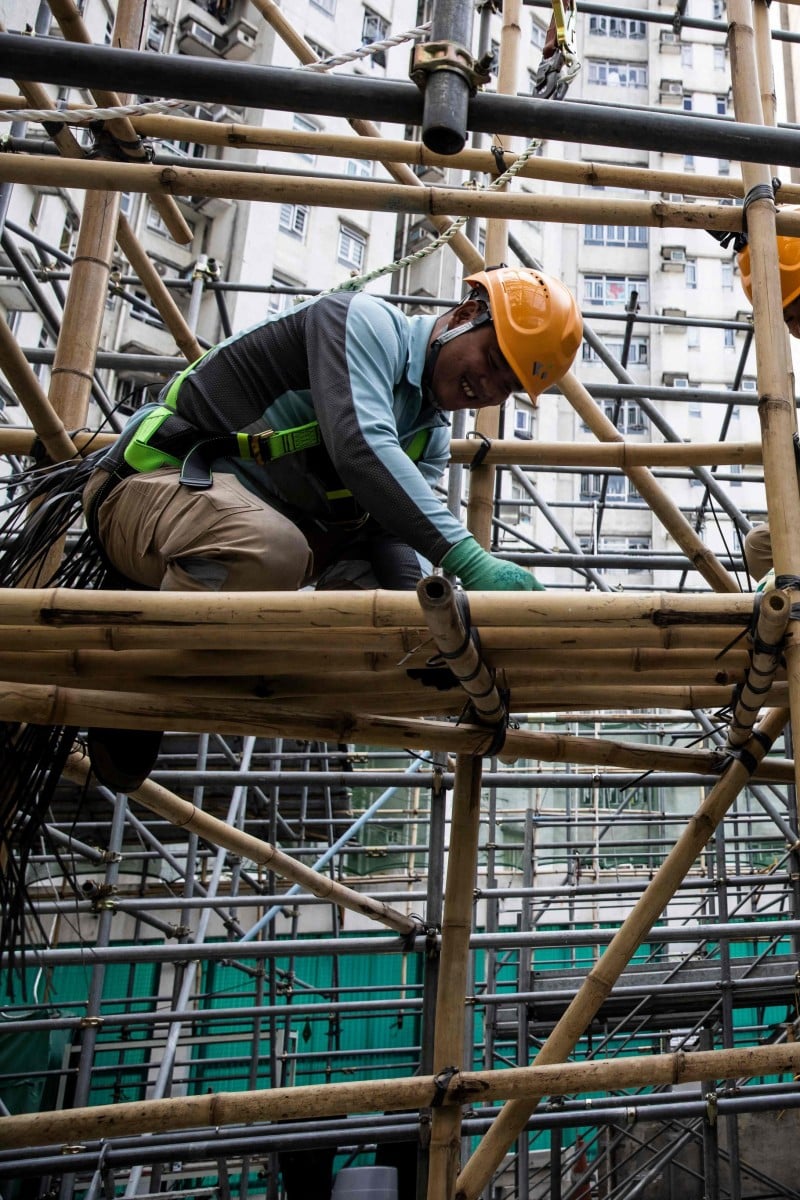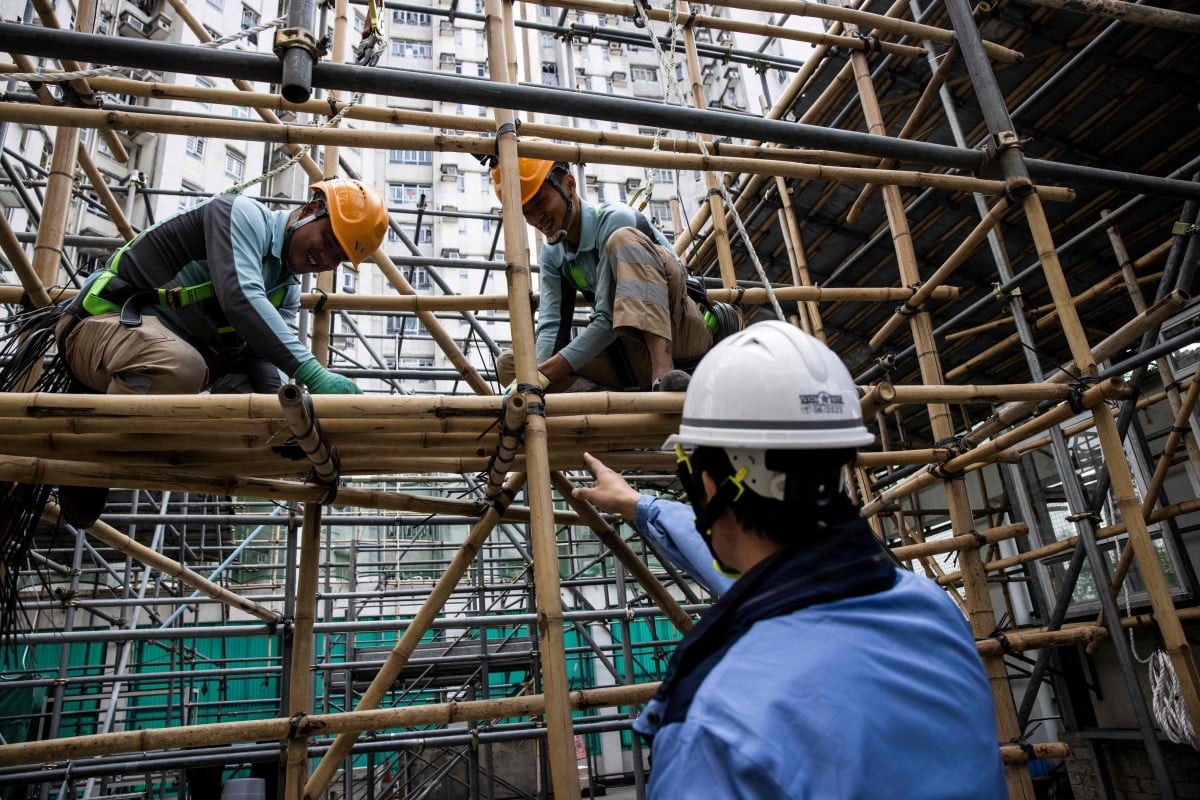
5-minute listening: Hong Kong’s bamboo scaffolders preserve centuries-old construction method
- Traditional technique was once widespread in China and elsewhere in Asia, but most have now switched to materials such as steel and aluminium
- Practise your English with our short listening exercises: play the audio linked below; complete the questions; and check the answers at the bottom of the page
 Ho Cheuk-wai (left) and Mo Jia-Yu (top right) receive instructions during a bamboo scaffolding class. Photo: AFP
Ho Cheuk-wai (left) and Mo Jia-Yu (top right) receive instructions during a bamboo scaffolding class. Photo: AFPQuestions
1. What are Mo Jia-yu and Ho Cheuk-wai training to become?
A. bamboo scaffolders
B. bamboo scaffolding instructors
C. construction specialists
D. building repair specialists
2. What does the word “metropolis” at the beginning of the podcast refer to?
A. bamboo poles
B. China
C. bamboo scaffolds
D. Hong Kong
3. What is another name for scaffolders according to the podcast?
A. monkeys
B. spiders
C. flying squirrels
D. bats
4. If a job requires someone with “agility”, they must ...
A. be able to move quickly and easily.
B. have good judgment.
C. be good at sports.
D. like to meet and spend time with people.
5. How long has Mo been taking classes at the Construction Industry Council?
A. less than five weeks
B. close to three months
C. more than half a year
D. about one year
6. What do students at the Construction Industry Council learn?
A. how to tie knots
B. how to sit on the bamboo frame
C. how to work on the scaffolds
D. all of the above
7. What is the first thing that is taught at the Construction Industry Council’s bamboo scaffolding course?
A. how to wear the safety harness properly
B. how to choose bamboo poles for the scaffolds
C. how to tie the basic knot that holds the poles together
D. how to climb up bamboo scaffolds
8. Which word can replace “widespread” in the sentence, “Scaffolding using bamboo dates back centuries and was once a widespread practice across China”?
A. pervasive
B. broad
C. common
D. complete
9. Instead of bamboo, what are most cities in Asia building scaffolds with these days?
A. metal
B. bricks
C. concrete
D. plastic
10. If something is “intricate”, it ...
A. is twisted together in an untidy way.
B. has many different parts and small details that fit together.
C. costs a lot of money to produce.
D. is created using the most advanced techniques.
11. Why is bamboo still used in Hong Kong’s scaffolds?
A. because the material can be purchased easily
B. because it is easy to transport
C. because it is cheaper compared to other alternatives
D. all of the above
12. How much does one bamboo pole cost?
A. 15 HK cents
B. 50 HK cents
C. HK$1.50
D. HK$15
13. Why is scaffolding considered a dangerous profession according to the podcast?
A. because of the industry’s lack of safety guidelines
B. because of the extremely sharp tools used
C. because of the work environment
D. because of the lack of training given to bamboo scaffolders
14. Which word can replace “dizzying” in the podcast?
A. bewildering
B. rapid
C. shaky
D. none of the above
15. Refer to the end of the podcast; how does Chang feel about bamboo scaffolding?
A. It is a skill that is unique to Hong Kong and worth preserving.
B. It is an archaic way of construction that needs to be phased out.
C. It is an effective construction method that other cities should learn from.
D. It is a disappearing trade which has no place in Hong Kong.
Answers
1. A
2. D
3. B
4. A
5. B
6. D
7. C
8. C
9. A
10. B
11. D
12. D
13. C
14. D
15. A
Script
Adapted from Agence France-Presse
Voice 1: Mo Jia-yu wraps his legs around a pole to balance high above the ground and secure a joint. This is a skill he must master to become a bamboo scaffolder in Hong Kong.
Voice 2: The metropolis is one of the world’s last remaining cities to use bamboo scaffolding in modern construction and building repair. It is common to see scaffolders perched on bamboo frames that are several storeys high. Hongkongers have nicknamed these workers “spiders” because of their agility over the web-like latticework.
Voice 1: Mo is among dozens of students who enrol each year at the city’s Construction Industry Council to learn the traditional method. Mo, who has been at the school for nearly three months, said being a scaffolder required a daring heart.
Voice 2: At the Construction Industry Council, students learn how to firmly saddle the bamboo frame so that they can free up their hands to work on the scaffolds, which are held together with simple knots tied using nylon strips.
Voice 1: According to another student, Ho Cheuk-wai, all students have to first learn the basic knot. They had to practise this for an entire week to get it right. Thereafter, the instructors will teach them how to put on the safety harness, and step-by-step students learn how to build all the way to the top.
Voice 2: Scaffolding using bamboo dates back centuries and was once a widespread practice across China and elsewhere in Asia. Most cities in the region have phased it out in favour of materials such as steel and aluminium. But in Hong Kong, intricate bamboo webs are still part of the cityscape, latticed around both old residential flats and glitzy skyscrapers.
Voice 1: Its popularity in the city is because of its price and efficiency. Bamboo is readily available across the border in southern Chinese provinces. A bamboo pole costs around HK$15 compared with HK$280 for one made of metal.
Voice 2: Lightweight bamboo is also easier to transport through a cramped urban centre. It is flexible, allowing builders to cut poles to desired lengths for different construction sites.
Voice 1: Scaffolding is regulated by strict safety guidelines but is still viewed as a dangerous profession since the work is often done at dizzying heights. According to Wallace Chang, a professor at Hong Kong University’s architecture department, workers need courage as well as skill to survive in the industry. Despite the perils involved in the craft, Chang hopes Hong Kong will preserve it as part of its cultural heritage.
